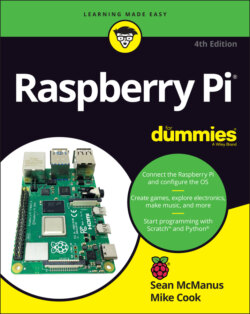Читать книгу Raspberry Pi For Dummies - McManus Sean, Evans Jonathan, Sean McManus - Страница 65
Using the Image Viewer
ОглавлениеIt’s easy to look at your digital photos and other images. Among the accessories on the Applications menu is the Image Viewer. You can start it from the menu (in the Graphics folder) or by double-clicking or right-clicking an image file.
GpicView, written by Hong Jen Yee / Raspberry Pi Foundation
FIGURE 4-9: Gnomes on phones, as seen through the Image Viewer.
The Image Viewer displays the picture, with a toolbar underneath it, as you can see in Figure 4-9. From left to right, this is what the buttons do:
Previous: Goes to the previous photo in the folder. Note that any unsaved changes (such as rotation) are lost. You can also use the left-arrow key on the keyboard.
Next: Goes to the next photo in the folder. As with the Previous button, clicking this discards any unsaved changes you’ve made to the current photo. You can also use the right-arrow key on the keyboard.
Start Slide show: Begins a slide show of all photos in the folder. The interval between photos is set at 5 seconds, but you can change it in the preferences. You can also press the W key to start a slide show. There might be a short delay before the slide show begins.
Zoom Out: Reduces the magnification of the image. The keyboard shortcut is the Minus (–) key.
Zoom In: Increases the magnification of the image. Scroll bars appear if the image becomes too big to fit in the Image Viewer, and you can use these to see different parts of the picture. The keyboard shortcut is the plus sign (+) key, with no need to use Shift.
Fit Image to Window: Shrinks a large image to make it fit the Image Viewer snugly. If an image is smaller than the Image Viewer window, it won’t be blown up to fill it, though. This button (or its keyboard shortcut, F) is a good way to recover if you get lost zooming in or out.
Go to Original Size: Resets any zooming by showing the image at its full original size. This might be bigger than the Image Viewer window, in which case scroll bars appear, to enable you to move around the image. The keyboard shortcut is G.
Full Screen: Expands the image to fill the monitor, so you lose the Image Viewer controls. Right-click the image to open a menu with all the same options. To revert to using the Image Viewer in a window, choose Full Screen from the menu or press ESC. You can also use the F11 key to switch the full screen view on and off. On the Raspberry Pi keyboard, use Fn+F1 in place of F11.
Rotate Left: Rotates the image 90 degrees counterclockwise. The keyboard shortcut is L.
Rotate Right: Rotates the image 90 degrees clockwise. The keyboard shortcut is R.
Flip Horizontally: Mirrors the image horizontally and can also be done with the H key.
Flip Vertically: Turns the image upside down. The V key does the same.
Open File: Opens a new image file. You can also drag and drop an image on the Image Viewer from a folder in File Manager. This doesn’t move the file — it just opens it.
Save File: Saves the image (including any rotations or mirroring you have done) and replaces the original image. You get a warning before it happens. Keyboard shortcut: S.
Save File As: Saves the image with a new filename so that it doesn’t overwrite the original image. (You can also press the A key to do this.) Use the menu at the bottom of the Save File As window to choose the image format.
Delete: Deletes an image from your storage device. If you delete an image, it’s not sent to the wastebasket: It’s deleted and cannot be recovered. You get one warning, but then it’s toast! You can also use the Delete key.
Preferences: Holds the settings you can change for Image Viewer so that you can customize it for your needs. You can turn off the warnings you get before overwriting or deleting an image, set Image Viewer to automatically save rotated images, change the background colors of Image Viewer, and change the slide show interval. There’s also an option to rotate images by changing their orientation value in the EXIF tag, which changes some of the information stored with the image to say which way up the camera was, instead of actually rotating the image content itself. It’s okay to keep this selected, but this is where you disable it, if you prefer.
Exit Image Viewer: Closes the Image Viewer application. You can also close the window by clicking the Close button in the top right as you would with any other window.
